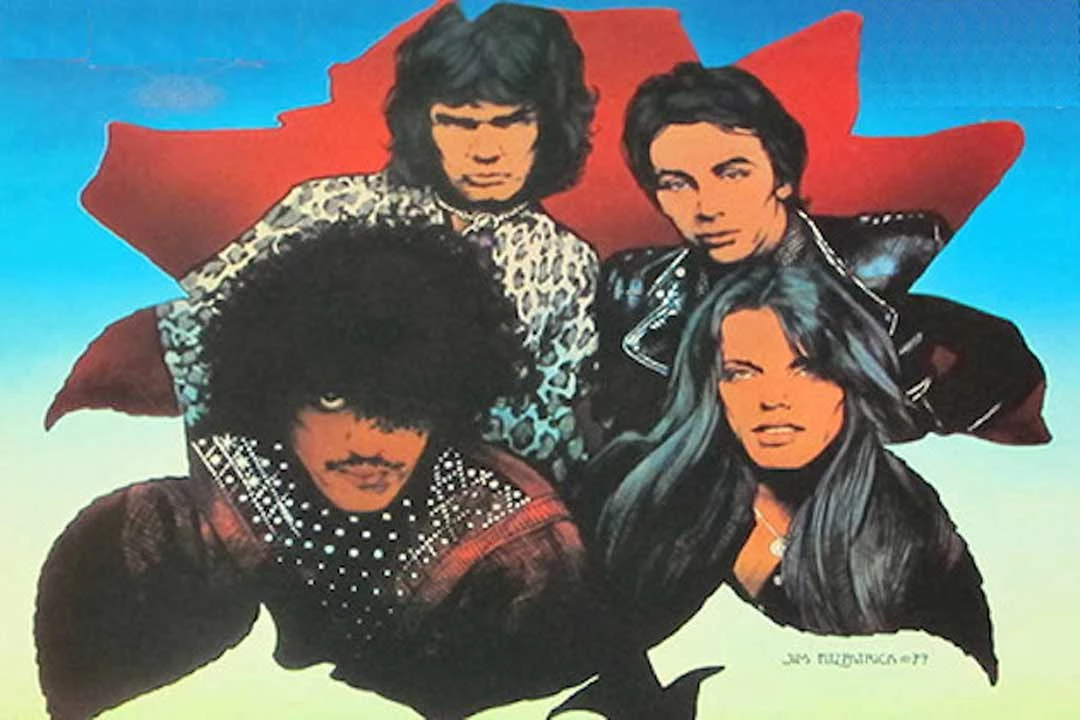
The second Thin Lizzy album cover to be designed by Jim Fitzpatrick was, he said, “a slightly odd one.” A transitional work that presages the band’s classic twin-guitar line-up, the influence of Roger Dean in the title lettering is clear, while there is also an admitted influence by the work of Marvel comic strip artists Jim Steranko and Jack Kirby, both of whom Fitzpatrick and Lynott were passionate fans. Thin Lizzy – Nightlife (1974, illustrated by Jim Fitzpatrick) “This was my first artwork for Thin Lizzy and probably my most ‘out there’ album cover I did for them.” (“I just glossed it up a little,” says Fitzpatrick.) Elsewhere, Fitzpatrick weaved in a pronounced Marvel comics and Celtic design aesthetic (in the latter, especially the triple spiral, which is symbolic of three domains: earth, sea and sky, and past/present/future). Commissioned by Lynott to design the cover for their third album, Fitzpatrick worked on the Thin Lizzy logo, which was based on a design by fellow Irish illustrator, and member of Dr. “Philip and I had a love of American comic books, poetry, Ireland and all things Irish, and a shared fatherless upbringing,” recollected Fitzpatrick. Thin Lizzy – Vagabonds of the Western World (1973, illustrated by Jim Fitzpatrick)ĭublin artist Jim Fitzpatrick was introduced to Philip Lynott in Neary’s pub, in Dublin’s city centre, by Lynott’s friend and Thin Lizzy tour manager, Frank Murray (who would subsequently manage The Pogues). Stephen’s Green”) directly references the back cover image by Dublin photographer Roy Esmond of Thin Lizzy doing exactly that. A lyric from the title track, meanwhile, (“the boys posed, standing in St.

Some of the album’s tracks also reference the suggested simplicity of the album cover: “Sarah” (the first of two Lynott-composed songs of the same title) was written for Lynott’s Dublin-based grandmother, in whose house he lived for much of his childhood. The title of Thin Lizzy’s second album, meanwhile, referenced previous bands for Lynott (Orphanage) and Bell (Shades of Blue).

The evocative sepia-tinted cover image of three shoeless waifs (originally titled Street Urchins at Lambeth, by Paul Martin) was clearly intended to represent vocalist Philip Lynott, guitarist Eric Bell, and drummer Brian Downey. Thin Lizzy – Shades of a Blue Orphanage (1972, design by Decca in-house cover art photograph by Radio Times Hulton Picture Library) “The work of our department,” wrote David Wedgbury in the preface to his photography book, As Years Go By – the 60s Revolution at British Decca, “did much to establish and influence the emerging art of pop photography.”

The back cover photography is attributed to Jennifer Edwards (although Dublin photographer Roy Esmond’s uncredited work is also featured). He died suddenly in 1998, aged 61, having photographed 1960s music talent that would change pop culture forever. Wedgbury quickly gravitated towards art design for the label, and then creative studio manager. The appealing fisheye lens cover image was taken by David Wedgbury, the first staff photographer to be employed by Decca. Thin Lizzy signed with Decca Records on December 1, 1970, and within five months their debut album was released.

Thin Lizzy – Thin Lizzy (1971, design by Decca in-house cover art photograph by David Wedgbury)


 0 kommentar(er)
0 kommentar(er)
